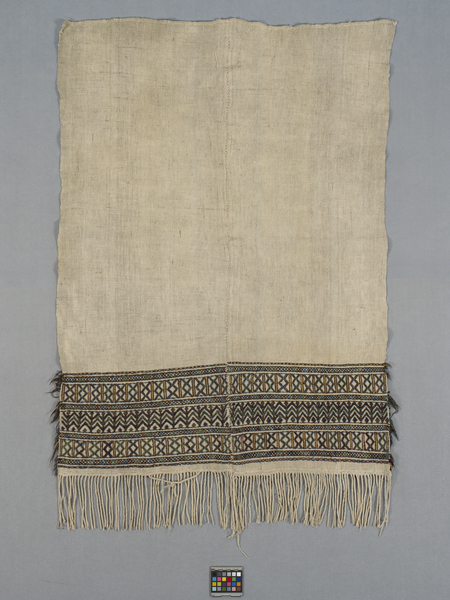Shawl Item Number: 2878/2 a from the MOA: University of British Columbia


Description
Light brown shawl made of two pieces of textile sewn together. There are several lines of geometric designs on the bottom of the textile next to the fringe, which include: “zyak chot” or line dance design, “mun-gu-zyeek chot” or fly design, “bir-ra kum-ba chot” or male goat (or markhor/wild goat) crossed horn, “o-si-chin gam-bu-ri chot” or sallow tree flower design (which is found in the centre), and "mishari chot" or mixed design. The designs are woven from several different colours of wool. The reverse side shows the loose thread ends from the designs. (Part b is a needle used for fastening).
History Of Use
To wear this shawl, a woman wraps it around her body at the height of her armpits starting with one (undecorated) edge lined up above the right breast. It is then wrapped around the body at the back (armpit height) and the woven end goes over the left shoulder and is brought across the chest and pinned to the original edge of the wrap above the right breast.
Narrative
This shawl was woven by a woman from the Dramase clan in the Rumbur Valley. It is made by weaving two separate strips of exactly the same size and design patterns, which are then cut off the loom and stitched together down the center, creating a single garment. The two outermost lines of woven design (those at the top and bottom) represent a line of dancers linked arm in arm.
Item History
- Made in Northwest Frontier, Pakistan
- Collected during 1990
- Owned by Tamarin Productions Inc. before May 4, 2011
- Received from Tamarin Productions Inc. (Seller) and Ruth Read Bequest (Funding source) on May 4, 2011
What
- Name
- Shawl
- Identification Number
- 2878/2 a
- Type of Item
- shawl
- Material
- wool fibre and dye
- Overall
- height 133.5 cm, width 88.5 cm
Who
- Culture
- Kalash
- Previous Owner
- Tamarin Productions Inc.
- Received from
- Tamarin Productions Inc. (Seller) and Ruth Read Bequest (Funding source)
Where
- Holding Institution
- MOA: University of British Columbia
- Made in
- Northwest Frontier, Pakistan
When
- Collection Date
- during 1990
- Ownership Date
- before May 4, 2011
- Acquisition Date
- on May 4, 2011
Other
- Item Classes
- textiles
- Condition
- good
- Accession Number
- 2878/0002 a